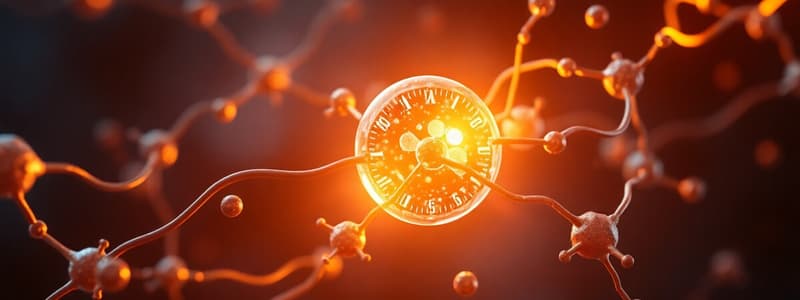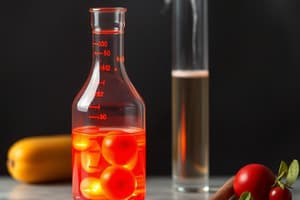Podcast
Questions and Answers
What are the two types of pathways nutrients can take once inside cells?
What are the two types of pathways nutrients can take once inside cells?
In oxidation-reduction reactions, what does the term 'oxidation' specifically refer to?
In oxidation-reduction reactions, what does the term 'oxidation' specifically refer to?
What mnemonic can help remember the relationship between oxidation and reduction?
What mnemonic can help remember the relationship between oxidation and reduction?
What is primarily produced when glucose is oxidized?
What is primarily produced when glucose is oxidized?
What is the sum of all biochemical reactions inside a cell known as?
What is the sum of all biochemical reactions inside a cell known as?
Which of the following correctly contrasts DNA and RNA?
Which of the following correctly contrasts DNA and RNA?
What role does ATP play in cell metabolism?
What role does ATP play in cell metabolism?
Which of these statements regarding nutrients and energy is correct?
Which of these statements regarding nutrients and energy is correct?
What role does oxygen play in oxidative phosphorylation?
What role does oxygen play in oxidative phosphorylation?
During which process is a high-energy phosphate group directly transferred to ADP?
During which process is a high-energy phosphate group directly transferred to ADP?
Which of the following pathways does NOT require oxygen?
Which of the following pathways does NOT require oxygen?
How many ATP are produced from the complete catabolism of one molecule of glucose?
How many ATP are produced from the complete catabolism of one molecule of glucose?
What is primarily created as a result of the proton gradient in oxidative phosphorylation?
What is primarily created as a result of the proton gradient in oxidative phosphorylation?
Which of the following is a key process that occurs in glycolysis?
Which of the following is a key process that occurs in glycolysis?
What does the citric acid cycle primarily generate during glucose metabolism?
What does the citric acid cycle primarily generate during glucose metabolism?
Which molecule is considered the primary energy source in cellular respiration?
Which molecule is considered the primary energy source in cellular respiration?
What happens to glucose during cellular respiration?
What happens to glucose during cellular respiration?
Which of the following statements about ATP is true?
Which of the following statements about ATP is true?
What role do coenzymes NAD+ and FAD play in metabolism?
What role do coenzymes NAD+ and FAD play in metabolism?
What is the primary method of ATP production during glycolysis?
What is the primary method of ATP production during glycolysis?
What is the consequence of burning wood in terms of redox reactions?
What is the consequence of burning wood in terms of redox reactions?
Which vitamin is a precursor for the coenzyme NAD+?
Which vitamin is a precursor for the coenzyme NAD+?
What happens to ATP when it releases energy?
What happens to ATP when it releases energy?
Which of the following is NOT a characteristic of substrate-level phosphorylation?
Which of the following is NOT a characteristic of substrate-level phosphorylation?
What is the primary function of glycolysis?
What is the primary function of glycolysis?
In the absence of oxygen, NADH is converted back to NAD+ by donating its electrons to which of the following compounds?
In the absence of oxygen, NADH is converted back to NAD+ by donating its electrons to which of the following compounds?
Where does the citric acid cycle occur within the cell?
Where does the citric acid cycle occur within the cell?
What is produced from one molecule of glucose during glycolysis?
What is produced from one molecule of glucose during glycolysis?
What must happen to pyruvic acid before it can enter the citric acid cycle?
What must happen to pyruvic acid before it can enter the citric acid cycle?
How many acetyl CoA molecules are formed from one glucose molecule in glycolysis?
How many acetyl CoA molecules are formed from one glucose molecule in glycolysis?
Which of the following is NOT a product of glycolysis?
Which of the following is NOT a product of glycolysis?
What happens to pyruvic acid when oxygen is present?
What happens to pyruvic acid when oxygen is present?
What is the outcome of transferring Hs to NAD+?
What is the outcome of transferring Hs to NAD+?
What role does ATP synthase play in the electron transport chain?
What role does ATP synthase play in the electron transport chain?
Which process forms glycogen from glucose?
Which process forms glycogen from glucose?
What is the primary function of glycogen in the liver when blood glucose levels drop?
What is the primary function of glycogen in the liver when blood glucose levels drop?
What does the process of gluconeogenesis produce?
What does the process of gluconeogenesis produce?
What signifies high cellular ATP levels in relation to glycolysis?
What signifies high cellular ATP levels in relation to glycolysis?
Which statement describes the process of glycogenolysis?
Which statement describes the process of glycogenolysis?
When does the process of gluconeogenesis primarily occur?
When does the process of gluconeogenesis primarily occur?
Flashcards are hidden until you start studying
Study Notes
Metabolism
- Metabolism refers to all biochemical reactions within a cell.
- Food digestion and absorption provide cells with nutrients.
Nutrient Processing
- Anabolic pathways use nutrients to build complex molecules.
- Catabolic pathways break down nutrients to produce energy, often in the form of ATP.
Oxidation-Reduction Reactions
- Oxidation involves gaining oxygen or losing hydrogen atoms (and electrons).
- Reduction involves gaining electrons.
- Redox reactions usually involve an oxidized substance losing electrons and a reduced substance gaining electrons.
Capturing Energy from Food
- Glucose, a highly reduced molecule, is catabolized to release energy.
- Oxygen acts as the final electron acceptor in glucose oxidation.
- Energy released from glucose oxidation is used to make ATP.
Redox Enzymes and Coenzymes
- Redox reactions are catalyzed by enzymes, which often require B vitamin coenzymes.
- NAD+, derived from niacin (Vitamin B3), can be reduced to NADH + H+ to accept hydrogen atoms.
- FAD, derived from riboflavin (Vitamin B2), can be reduced to FADH2 to accept hydrogen atoms.
Adenosine Triphosphate (ATP)
- ATP is used by all forms of life to power chemical reactions.
- ATP briefly stores chemical energy, then transfers it to an enzyme for a chemical reaction.
- This process converts ATP to ADP, which is then recharged into ATP.
ATP Synthesis
- Two mechanisms synthesize ATP: substrate-level phosphorylation and oxidative phosphorylation.
- Substrate-level phosphorylation uses energy from broken chemical bonds to attach phosphates to ADP.
- Oxidative phosphorylation uses a proton gradient to power ATP synthesis.
Overview of Cellular Respiration
- Cellular respiration is the process that converts energy from food into ATP.
- Cellular respiration has three main stages: glycolysis, the citric acid cycle, and the electron transport chain.
Substrate-level Phosphorylation
- Substrate-level phosphorylation transfers phosphate groups to ADP from phosphorylated molecules.
- It occurs twice in glycolysis and once in the citric acid cycle per glucose molecule.
- This process does not require oxygen.
Oxidative Phosphorylation
- Oxidative phosphorylation uses energy from food to create a proton gradient across the mitochondrial membrane.
- This gradient is used to power phosphorylation of ADP into ATP.
- Oxidative phosphorylation requires oxygen for the final step in the electron transport chain.
Oxidation of Glucose
- Glucose is our primary energy source.
- Complete glucose catabolism involves three pathways: glycolysis, the citric acid cycle, and the electron transport chain.
Glycolysis
- Glycolysis is a 10-step pathway that occurs in the cytoplasm.
- Glycolysis operates with or without oxygen, meaning it is anaerobic.
- One glucose molecule is broken down into two pyruvate molecules.
- Glycolysis generates a net gain of two ATP molecules.
Glycolysis (continued)
- Limited NAD+ supply means NADH must donate its accepted hydrogen atoms to become NAD+ again to continue the cycle.
- In the absence of oxygen, NADH returns its hydrogen to pyruvate, forming lactate, allowing NAD+ to continue as an electron acceptor.
- With sufficient oxygen, lactate is oxidized back to pyruvate and enters aerobic pathways.
Citric Acid Cycle (Krebs Cycle)
- The citric acid cycle occurs in the mitochondrial matrix.
- This step is fueled by pyruvate from glucose breakdown and fatty acids from fat breakdown.
- Pyruvate must be actively transported into the mitochondria.
- Once inside, pyruvate enters the transitional phase, where it is converted to acetyl CoA if oxygen is available.
Citric Acid Cycle (Krebs Cycle)
- Pyruvate loses a carbon atom as CO2 and two hydrogen atoms as it enters the mitochondria.
- The resulting acetic acid molecule is attached to coenzyme A to form acetyl CoA, which enters the cycle.
- Hydrogen atoms are transferred to NAD+ to produce NADH+H+.
Electron Transport Chain
- The electron transport chain uses energy from NADH and FADH2 to move protons across the mitochondrial membrane.
- This creates a proton gradient.
- As protons flow back through ATP synthase, energy is used to phosphorylate ADP into ATP.
ATP from Cellular Respiration
- Each glucose molecule yields approximately 30 ATP molecules.
- This process is more efficient than substrate-level phosphorylation alone.
Storing Sugar for Later
- Glycogenesis is the process of forming glycogen, the animal carbohydrate storage product, from glucose.
- High cellular ATP inhibits glycolysis, favoring glycogen synthesis.
- This occurs mainly in the liver and skeletal muscles.
Releasing Previously Stored Sugar
- Glycogenolysis is the breakdown of glycogen into glucose molecules.
- This occurs when blood glucose levels decrease.
- In most cells, glycogen is broken down to glucose but stays within the cell for glycolysis.
- In the liver, glycogen breakdown produces glucose for the bloodstream, for use by all tissues.
Making Sugar out of Protein or Fat
- Gluconeogenesis is the production of glucose from non-glucose molecules, such as glycerol or amino acids.
- This process helps maintain blood glucose levels when dietary sources and glucose reserves are depleted.
Studying That Suits You
Use AI to generate personalized quizzes and flashcards to suit your learning preferences.




